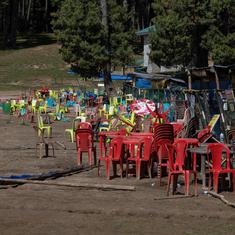Every year, thousands of young students from all over the country arrive in Kota, a city in Rajasthan, where they camp for a couple of years. Their mission: taking tuitions to clear their final examinations and cracking entrance tests in their bid to earn a coveted engineering or medical seat at a prestigious institution.
Kota coaching centres are renowned for sending thousands of students to top institutions, but the associated pressures and competitive nature have also made them infamous for driving students to depression and even suicide.
This problem is emblematic of the larger malaise in our education system: parents and students do not think that the public education system is good enough.
Fresh data released by the National Sample Survey Organisation, a government agency that conducts socio-economic surveys, confirms this notion. Released a few weeks ago, the data pertains to expenditure trends in Indian households on education and points out how quickly the inclination to take up private coaching has been rising across the country.
According to the data, 7.1 crore students in the country are taking private tuitions, out of which 4.1 crore are boys and 3 crore are girls.
To put this in perspective, one in every four students visits some sort of private tuition facility apart from school. What’s more, the poor are almost as likely to take recourse in private tuitions as the rich, implying that it’s no longer considered a luxury but a necessity to excel.
The survey was conducted in the first half of 2014 when the market size of the private coaching industry was over Rs 1.56 lakh crore, according to industry body ASSOCHAM. The size of this industry has now conflated to an estimated Rs 2.6 lakh crore, even as the government continues to assert that it wants to move people off the shadow education system that has mushroomed through private coaching centres.
Lack of agility
That private tuitions are getting popular in India is well-known. They have been the norm for higher education entrance examinations for decades now, ever since the Indian Institutes of Technology and the Indian Institutes of Management were established. What’s more recent, however, is the mad rush that starts way before senior secondary level, as students queue up for coaching centres to bolster their basics and get a head start in their quest to ace entrance exams.
According to a Hindustan Times report, students are joining entrance coaching centres as early as Class 6 to prepare for an exam that will happen six years later. These “foundation programmes” start at Class 6 in some institutes, while they begin at Class 7 or 8 in others. A director of one such institute, FIITJEE, which trains aspirants for engineering and medical exams, told the newspaper that “children need to get into the spirit of competition early.”
Despite these revelations, less than 2% of those polled by NSSO said that they were joining the tuition centres for earning admission into their preferred course or institution. Interestingly, only about 8% of those seeking private coaching were doing it to land their preferred job – pointing to the perceived lack of agility in the formal education system in creating job-ready candidates.
Public vs private
The rot in the public education system is further evident following a look at the proportion of students taking private tuitions. According to the NSSO data, more students taking up private coaching were studying in government schools and colleges as compared to private institutions.
“Uniformly, it was seen that students attending government institutions were spending proportionately more on private coaching than students attending private institutions,” the report states. “Comparatively, students studying in private institutions were spending less on private coaching in both rural and urban areas.”
It added that private coaching was most popular in rural areas at secondary level (33%), while in urban areas it was most commonly seen as a trend among students at the higher secondary level (46%).
Private coaching is a shadow education system that may or may not guarantee better results, but it is certainly burning holes in household budgets. The survey reported that expenditure on private coaching is the third biggest spend that families make on education of children, after school fees and cost of books and stationery.
In pure terms, it constitutes about 12% of the total expenditure on education which may not seem like much, but could still put a substantial burden on rural households, where expenditure on private schools was recorded to be 15-20 times more than government-run institutions.














